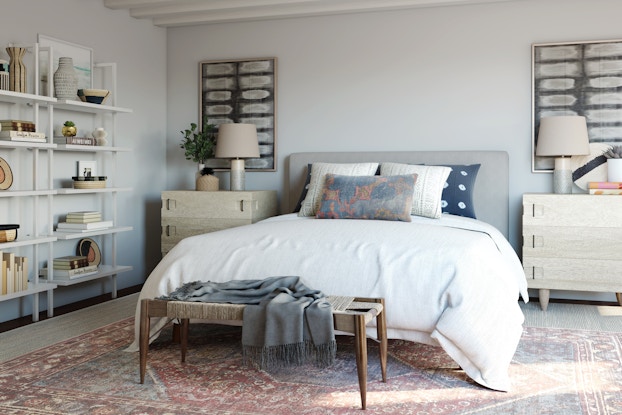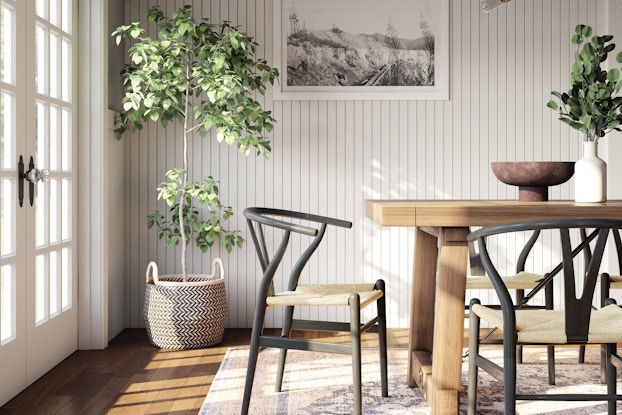
Great service can be hard to scale, and personalization even more so.
One San Francisco-based startup, Modsy, is looking to democratize interior design by giving subscribers access to the high-tech digital tools, professional guidance and retail assortments once exclusive to professional interior designers.
Frustrated by her own experience trying to decorate a new home, CEO Shanna Tellerman founded the company in 2014. At its core, Modsy is a product discovery platform that also happens to deliver design services tailored to the needs of each individual user. After a detailed quiz to generate product suggestions, customers simply upload photos and dimensions of their space, which is then generated as a 3D rendering in which users get a realistic look at how an item will fit in the space.
While online marketplaces like Wayfair offer near unlimited options, and digital tools like Pinterest and Houzz provide platforms for inspiration gathering and image organization, Modsy aims to bridge the two, further easing overwhelmed customers with the added benefit of guidance from a design professional.
Modsy’s unique value proposition revolves around using its technology to remove friction points from the home design experience and offer personalized service to consumers who might never have considered hiring a decorator in the first place.
We’ve been able to leverage that notion that the modern consumer expects not only services like personalization and customization, but they expect technology to empower them to make the best decisions.Alessandra Wood, style director, Modsy
Leverage tech
Modsy differentiates itself in the industry by using tech algorithms to understand its customers' personal style preferences. Read more interesting tech trends that are influencing consumer shopping habits.
Building customer confidence as the home industry moves online
“When it comes to home design and furniture, it’s an industry that is historically very slow to change,” Alessandra Wood, style director for Modsy, told CO— at the Business of Home’s September “Future of Home” conference, after her appearance on the panel, the "Future of On-Demand Design."
Nevertheless, Modsy hopes to help bring the category into a world of consumer expectations shaped by Amazon Prime. “Working with traditional interior designers can be a time- and money-intensive process and quick-ship furniture is still an area ripe for disruption,” Wood said.
Indeed, Modsy arrives at an interesting juncture for the home industry. Despite stalling sales and store closures for many legacy retailers, the home improvement and design categories have maintained steady growth, particularly as the industry moves online. At 18.2% growth, the home furnishings category was fastest amongst all product categories measured by eMarketer in 2017.
Regardless, furniture is a category that has been somewhat slow to embrace e-commerce. Given the size, price point and level of commitment involved, many customers, even tech-addicted millennials, prefer to see and feel products in store before purchasing. According to data from Fung Global Retail & Technology, 47% of millennials surveyed research items online before ultimately purchasing in store, while only 3% of respondents feel no need to experience items in person before making an online purchase.

Building a customized experience by harnessing data
Modsy has thus far been able to make a name for itself by tapping into two key consumer trends of the last half of this decade: expectations for quick online service and demand for a customized experience. “We’ve been able to leverage that notion that the modern consumer expects not only services like personalization and customization,” Wood told the audience at Future of Home, “but they expect technology to empower them to make the best decisions.”
Its delivery of customization is twofold: Modsy uses the customer’s actual living space to develop 3D renderings, then offers a custom curated design offering from its nationwide network of interior designers based on the results of a proprietary Style Quiz.
“Our technology provides not just service but the confidence to know that the decision-making process is seamless,” Wood told the Future of Home audience, speaking to Modsy’s position at the intersection of design and technology.
One of the ways Modsy’s service helps customers build confidence in their purchasing is be helping them identify and then communicate their own personal style. “It’s hard for customers to tell you and describe their style using words,” Wood said, emphasizing the function of algorithms to help understand and translate users’ preferences into a design plan. And as is a typical network effect for an online business built around the power of data, the more data Modsy collects, the more customized its offering becomes.
Expanding beyond service, Modsy has leveraged the data it collects to develop Ravine Home, an in-house line of custom sofas and chairs. “We looked at thousands of customer data points and feedback to build beautiful, high quality and affordable pieces that are manufactured in the USA,” Wood says of the line, which launched in March 2019 and is exclusive to Modsy users. “The response has been incredible. Customers have really responded to knowing we are listening to their insights and requests.”

Fueling the future of interior design
Modsy’s emergence comes as interior design professionals are adjusting their value propositions to meet the changing expectations and needs of millennial (and, soon enough, Gen Z) consumers. Designers are no longer the gatekeepers between brands and consumers, who are more educated than ever thanks to the internet and crave the transparency in pricing and manufacturing that they have come to expect from other categories. It’s also no longer just a luxury service, available only to the highest-end clients.
Though Modsy remains focused for now only on its customer-facing business, it sees the potential to occupy an important space in this industry as it evolves. “We know that a few designers come in as Modsy customers under the radar, with their clients,” Wood told the audience at Future of Home when asked if the service might someday evolve as a business-to-business product. “It’s an amazing way to create affordable photorealistic renders of a space,” she said. “We recognize that there is a use case for that, but right now, we’re hyper-focused on delivering the best experience possible for our [existing] customers.”
Its success will hinge on its ability to continue successfully scaling its tech-enabled service, even as the shopping experience becomes increasingly multi-channel and services like Amazon Prime ratchet expectations sky high.
“Through advancements in technology,” Wood said, “the gap that exists between inspiration and the reality of buying furniture and putting it in your space will become smaller and smaller.”
CO— aims to bring you inspiration from leading respected experts. However, before making any business decision, you should consult a professional who can advise you based on your individual situation.
CO—is committed to helping you start, run and grow your small business. Learn more about the benefits of small business membership in the U.S. Chamber of Commerce, here.

Interested in a small business membership?
Find out how the U.S. Chamber of Commerce can help your company grow and thrive in today's rapidly-evolving business environment. Connect with our team to learn how a small business membership can benefit your bottom line and help you achieve your goals.







